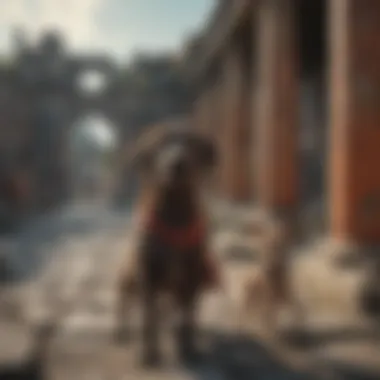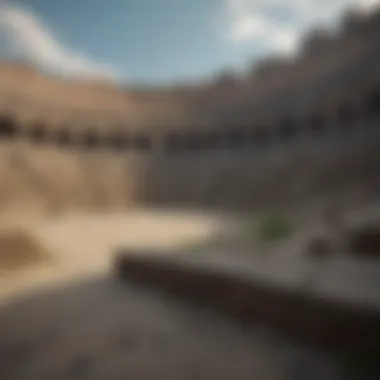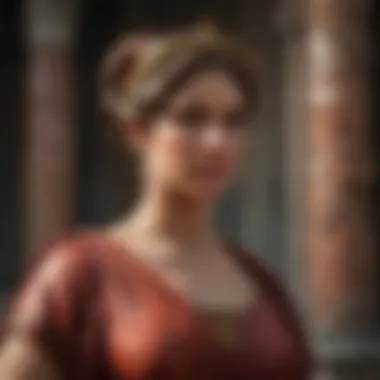Unveiling the Enigmas of Pompeii, Italy: A Journey into Timelessness


Nature Topic Overview
Pompeii, Italy, a city frozen in antiquity by the catastrophic eruption of Mount Vesuvius, offers a haunting glimpse into the lives of its ancient inhabitants. Preserved under layers of ash and pumice, Pompeii stands as a time capsule of Roman civilization, awaiting discovery and exploration.
Fun Facts and Trivia
Intriguingly, many structures in Pompeii still remain intact centuries after the eruption, unveiling intricate details of Roman art, architecture, and daily life. The city's amphitheater, famed for gladiatorial contests, echoes with the cheers of a bygone era, while mosaics and frescoes depict scenes of ancient festivities and rituals. Interactive digital reconstructions bring these ancient customs to life, captivating young minds with the vibrancy of Pompeii's past.
Wildlife Explorations
While Pompeii remains a testament to human history, it also harbors remnants of flora and fauna. From the resilient plant life emerging through ancient cobblestones to the occasional sighting of birds perched on timeworn ruins, nature finds a way to thrive amidst ruins. Learning about these adaptive species not only enriches children's understanding of Pompeii's ecosystem but also fosters a deeper appreciation for nature's resilience in the face of adversity.
Environmental Awareness
Exploring Pompeii prompts reflection on both its historical significance and the importance of conservation. Understanding how the city's preservation relies on ongoing efforts to conserve its structures underscores the critical need for sustainable practices. Educating children on the fragility of historical sites emphasizes the role of future generations in preserving our shared heritage, creating a sense of environmental responsibility from a young age.
DIY Nature Activities
Encouraging hands-on engagement with Pompeii's legacy, children can partake in DIY activities inspired by the city's art and architecture. Crafting Roman-inspired mosaics using everyday materials encourages creativity while connecting them to ancient artistic traditions. Guided outdoor explorations enable young learners to apply historical knowledge in real-world settings, fostering a holistic understanding of Pompeii's enduring legacy.
Introduction to Pompeii
Embark on a journey of discovery as we unravel the mysteries of Pompeii, Italy. This ancient city, frozen in time by a devastating volcanic eruption, offers a unique glimpse into a bygone era. Exploring Pompeii's rich history, architecture, and culture provides invaluable insights into the daily lives of its inhabitants, painting a vivid picture of the past.
Historical Significance
Origins of Pompeii
Delving into the origins of Pompeii sheds light on the foundation of this ancient city. The inception of Pompeii played a crucial role in shaping its identity within the Roman Empire. Understanding the origins of Pompeii is essential to grasping the context in which this thriving city existed. The unique blend of influences that contributed to Pompeii's development makes it a compelling subject for examination in this article. Unearthing the specific features of Pompeii's origins reveals fascinating details about its early days and sets the stage for further exploration.
Role in the Roman Empire
Pompeii's significance within the Roman Empire cannot be understated. The city's strategic location and economic importance made it a key player in the empire's network. Examining Pompeii's role provides valuable insights into how this city functioned within the broader Roman context. The specific contributions of Pompeii to the empire's cultural and political landscape make it a fitting focal point for this article. By delving into Pompeii's role, we gain a deeper appreciation for its impact and legacy within Roman history.
Discovery and Excavation
Initial Findings
The initial discoveries made during the excavation of Pompeii marked the beginning of a journey into the past. These findings offered a first glimpse into the city's buried treasures, igniting curiosity and scholarly interest. The significance of these initial excavations cannot be overstated, as they unveiled a world long forgotten. Exploring the key findings provides a foundation for understanding the complexities of Pompeii's preservation and the challenges that lie ahead.
Ongoing Archaeological Efforts
Continued archaeological endeavors have propelled our understanding of Pompeii to new heights. The ongoing efforts to unearth more of the city's secrets have yielded remarkable results, enriching our knowledge of ancient urban life. The relentless pursuit of knowledge through archaeological exploration is vital to preserving Pompeii's legacy for future generations. By examining the current excavations and research initiatives, we gain a comprehensive view of the ongoing quest to piece together Pompeii's intricate past.


Unique Preservation
Ash-covered Artifacts
The preservation of ash-covered artifacts provides a window into Pompeii's daily life before the disaster. These well-preserved objects offer tangible connections to the past, allowing us to visualize the city in its former glory. The remarkable state of these artifacts underscores the tragic suddenness of Pompeii's demise, freezing moments in time for modern interpretation. Exploring the significance of these ash-covered relics deepens our appreciation for the intricate details of Pompeii's material culture.
Body Casts
One of the most poignant aspects of Pompeii's preservation is the creation of body casts. These plaster molds, formed around the voids left by decaying bodies, capture the human tragedy of the city's destruction. The hauntingly lifelike nature of these casts conveys the emotional impact of the disaster, highlighting the human stories buried beneath the ash. Examining the role of body casts in Pompeii's preservation evokes a sense of empathy and remembrance for the lives lost, ensuring that their stories are not forgotten.
Life in Ancient Pompeii
In the exploration of Pompeii's mysteries, delving into the daily life of its ancient inhabitants provides a crucial understanding of the city's essence. From the city layout to cultural practices, Life in Ancient Pompeii encapsulates a diverse range of elements that showcase the societal dynamics of that era. Understanding the social structure and infrastructure not only offers insights into the past but also sheds light on how civilization evolved within Pompeii's boundaries.
City Layout and Infrastructure
Streets and Buildings
The intricate network of streets and buildings within Pompeii stands as a testament to ancient urban planning. The meticulous design of streets allowed for efficient movement and organized city life. The architecture of buildings, with its unique blend of functionality and aesthetics, reflected the sophistication of Roman engineering. Despite the challenges posed by disasters like volcanic eruptions, the construction techniques employed in Streets and Buildings highlight the resilience and adaptability of Pompeii's architecture.
Water System
Pompeii's advanced water system was a cornerstone of its infrastructure, providing a reliable water supply to its residents. The aqueducts and fountains dotted across the city not only served practical purposes but also contributed to the city's aesthetic appeal. The innovative techniques used in designing the Water System showcase the ingenuity of ancient engineers in harnessing natural resources for the benefit of the community.
Social Structure
Classes and Professions
The delineation of social classes and professions in Pompeii played a significant role in shaping daily life. From the affluent patricians to the working class, each segment of society had distinct roles and responsibilities. The hierarchies within Classes and Professions shaped social interactions and economic activities, providing a glimpse into the division of labor prevalent during that period.
Family Life
Family life in Pompeii revolved around strong kinship bonds and traditional values. The structure of families, with its emphasis on respect for elders and familial ties, underscored the importance of unity and cohesion within society. The rituals and customs associated with Family Life reflected the cultural richness of Pompeii, emphasizing the significance of lineage and heritage.
Cultural Practices
Religious Beliefs
Religious beliefs occupied a central place in the daily lives of Pompeii's inhabitants, influencing both personal conduct and communal celebrations. The array of temples and shrines dedicated to various deities exemplified the polytheistic nature of Roman religion. The Religious Beliefs upheld by the people showcased a mix of indigenous practices and imported cults, offering a mosaic of spiritual experiences within the city.
Entertainment
Entertainment in Pompeii ranged from theatrical performances to gladiatorial contests, catering to diverse preferences within the community. The amphitheaters and theaters served as prominent venues for social gatherings and cultural events, fostering a sense of camaraderie among the populace. The variety and quality of Entertainment options available in Pompeii reflected the city's vibrancy and creative spirit, providing avenues for leisure and artistic expression.
Architectural Wonders of Pompeii


In the exploration of Pompeii's architectural wonders, we unearth a treasure trove of historical significance that mirrors the ingenuity of the ancients. The city's buildings stand as eternal testaments to Roman architectural prowess, offering glimpses into their advanced engineering and aesthetic preferences. Delving into the architectural wonders of Pompeii sheds light on the urban planning, design principles, and artistic flourishes that characterized this ancient metropolis.
Public Buildings
Theater
The Theater of Pompeii emerges as a beacon of cultural and social gatherings, showcasing the Roman love for entertainment and dramatic performances. Its design epitomizes acoustic precision, ensuring every whisper resonates across the audience. The tiered seating arrangement reflects societal hierarchies, with prominent seats reserved for dignitaries. The Theater's ability to host large audiences amplified the reach of artistic expressions and political discourse, making it a pivotal space in the city's public life.
Amphitheater
The Amphitheater, a key feature of Pompeii's public landscape, illustrates the Romans' passion for gladiatorial combat and spectacles. Its oval structure allowed for efficient crowd management and optimal views of the gruesome contests below. The Amphitheater's capacity to evoke raw emotions and primal instincts among spectators highlights its integral role in shaping cultural identities and communal experiences. However, its association with violence and bloodshed also raises ethical considerations amidst the grandeur of Roman entertainment.
Private Residences
Villas
Pompeii's Villas epitomize luxury living for the affluent, boasting lavish architecture and intricate detailing that served as status symbols and private retreats. The layout of Villas around central courtyards fostered a sense of tranquility and opulence within domestic settings. Their opulent decorations and sprawling grounds reflected the owners' wealth and social standing, offering insights into the tastes and aspirations of Pompeii's elite class.
Atrium Houses
Atrium Houses, the more common residential structures in Pompeii, epitomize functional living spaces designed for practicality and comfort. Their central atriums served as gathering points for families, with surrounding rooms accommodating daily activities and social interactions. The simplicity of Atrium Houses reveals a lifestyle centered around familial bonds and community ties, emphasizing functionality over extravagance. Despite their modest appearances, these homes encapsulate the essence of everyday life in ancient Pompeii, showcasing the intimate spaces where mundane routines intertwined with moments of shared joy and sorrow.
Art and Culture in Pompeii
In this article, the focus shifts to the vibrant world of art and culture in Pompeii, shedding light on the essence of creativity and expression in this ancient Roman city. The art and culture of Pompeii play a crucial role in unraveling the layers of history and providing insights into the daily lives, beliefs, and aesthetics of its inhabitants. By exploring the artistic treasures left behind, we can decipher the values, traditions, and artistic achievements that defined Pompeian society.
Frescoes and Mosaics
Mythological Scenes
Mythological scenes depicted in frescoes and mosaics hold a special significance in Pompeii's art and culture. These artistic representations of mythological tales not only served as sources of entertainment but also carried symbolic meanings and cultural narratives. The intricate detailing and vivid colors of mythological scenes captured on walls and floors showcase the artistic prowess and storytelling skills of Pompeian artisans. By incorporating mythological elements, artists aimed to celebrate ancient myths, educate viewers, and perhaps instill a sense of wonder and awe in the audience. The choice of mythological scenes in this article enhances the narrative by providing a glimpse into the mythical beliefs and cultural values cherished by the Pompeian people.
Daily Life Depictions
On the other hand, daily life depictions in frescoes and mosaics offer a more grounded and realistic portrayal of Pompeian society. These artworks showcase scenes from everyday life, including domestic activities, social interactions, and local customs. By highlighting the mundane aspects of life, such as people at work, children at play, or individuals engaged in daily routines, daily life depictions provide a nuanced view of the Pompeian lifestyle. The authenticity and relatability of these depictions make them a valuable addition to this article, offering a glimpse into the human experiences and behavioral patterns prevalent in ancient Pompeii.
Sculptures and Statues
Marble Sculptures
Marble sculptures found in Pompeii exhibit exquisite craftsmanship and aesthetic beauty, reflecting the artistic sophistication of the time. The use of marble as a medium allowed artists to sculpt intricate details and convey emotions with remarkable precision. The lifelike quality of marble sculptures, characterized by graceful poses and fine anatomical details, adds a sense of realism and elegance to the artistic landscape of Pompeii. The durability and timelessness of marble make it a popular choice for sculptors, ensuring the preservation of their artistic legacy for future generations. The inclusion of marble sculptures in this article underscores the mastery of Pompeian sculptors and the enduring allure of their works.
Bronze Statuettes


Bronze statuettes found in Pompeii offer a different perspective on artistic expression, showcasing the versatility and artistry of metalworking in ancient times. These small-scale sculptures feature intricate designs, dynamic poses, and refined detailing, highlighting the technical skills of Pompeian metallurgists. The use of bronze as a medium allowed artists to create diverse statuettes representing mythological figures, deities, and ordinary individuals. The lustrous finish and malleable nature of bronze provided sculptors with creative freedom, enabling them to experiment with different styles and forms. By including bronze statuettes in this article, we broaden our understanding of Pompeii's artistic legacy and appreciate the ingenuity of artisans working with metallic mediums.
Legacy and Tourism
Embark on an enlightening journey to uncover the profound influence that Legacy and Tourism hold in the narrative of Pompeii's historical grandeur. These pivotal elements not only offer a window to the past but also serve as bridges connecting ancient traditions to contemporary society. Legacy transcends time, weaving tales of glory and downfall, shaping the present through the remnants of the past. Tourism, on the other hand, breathes life into Pompeii's relics, welcoming curious souls to walk alongside history's footsteps. The juxtaposition of legacy and tourism creates a harmonious balance, where preservation meets exploration, ensuring Pompeii's story endures for generations to come.
Influence on Modern Society
Art and Architecture
Dive deep into the realm of Pompeii's Art and Architecture, a testament to the timeless beauty that withstands the test of time. The intricate frescoes and majestic structures echo the creativity and sophistication of a bygone era. Art and Architecture serve as ambassadors of Pompeii's legacy, inviting admiration and study for their intricate details and aesthetic appeal. The fusion of artistry and structural design not only captivates the eye but also echoes the ingenuity of ancient craftsmen. While their preservation breathes life into history's whispers, their popularity among enthusiasts and historians cements their importance in preserving Pompeii's cultural heritage.
Historical Preservation
Uncover the essence of Historical Preservation, a guardian of Pompeii's past that safeguards its legacy for future generations. Through meticulous efforts and strategic interventions, historical preservation ensures that the vestiges of Pompeii remain intact, offering a glimpse into a world long gone. The careful curation of artifacts and structures not only protects their integrity but also provides a treasure trove of knowledge for scholars and enthusiasts. Historical Preservation stands as a beacon of hope, enlightening us about the importance of cherishing our collective past and the lessons it holds for the present.
Visitor Experience
Tourist Attractions
Embark on an odyssey to explore Pompeii's enchanting Tourist Attractions, a tapestry woven with tales of antiquity and wonder. The allure of ancient ruins and archaeological wonders beckons travelers from far and wide, offering a glimpse into the soul of Pompeii. Tourist Attractions serve as portals to the past, where history comes alive through crumbling walls and timeless sculptures. Their significance lies not only in their aesthetic appeal but also in their ability to transport visitors to a realm where time stands still, evoking awe and reverence for Pompeii's storied past.
Guided Tours
Immerse yourself in the educational extravaganza of Guided Tours, curated to enrich and enlighten visitors about Pompeii's rich tapestry of history and culture. Led by knowledgeable guides, these tours offer a deeper understanding of Pompeii's relevance in the annals of civilization. The guided exploration unravels the secrets hidden within Pompeii's ancient streets, providing a firsthand experience of the city frozen in time. While guided tours offer unparalleled insights and expert commentary, they also pose challenges in balancing information overload with sensory immersion, making them a double-edged sword in the realm of Pompeii's tourism landscape.
Preserving Pompeii's Heritage
Preserving Pompeii's heritage is a crucial aspect of this article, shedding light on the conservation efforts aimed at safeguarding the historical significance of this ancient city. By focusing on preservation, we can ensure that future generations have the opportunity to experience and understand the unique cultural legacy of Pompeii. The meticulous restoration projects and sustainability initiatives play a pivotal role in maintaining the integrity of this archaeological site, highlighting the dedication to conserving Pompeii's heritage for posterity.
Challenges and Conservation Efforts
Environmental Threats
The environmental threats posed to Pompeii stem from various factors like climate change, natural disasters, and human activities. These threats jeopardize the structural stability and preservation of the ruins, making it imperative to address them promptly. Understanding the impact of environmental threats allows for the implementation of measures to mitigate their effects, safeguarding Pompeii's cultural heritage from further deterioration.
Restoration Projects
Restoration projects in Pompeii focus on revitalizing and preserving the architectural structures and artifacts unearthed at the site. These projects involve meticulous craftsmanship and in-depth research to recreate the splendor of ancient Pompeian buildings. Through restoration efforts, the historical authenticity of Pompeii is maintained, offering visitors a glimpse into the city's former glory while ensuring its long-term conservation.
Future Prospects
Looking ahead, sustainability initiatives are crucial for the continued protection of Pompeii's heritage. By integrating sustainable practices into the preservation efforts, the site can be safeguarded for future generations without compromising its integrity. Sustainable initiatives not only contribute to the conservation of Pompeii but also raise awareness about the importance of environmental stewardship in heritage preservation.
Sustainability Initiatives
Sustainability initiatives in Pompeii focus on eco-friendly practices that promote conservation without causing harm to the environment. Implementing green technologies and sustainable methods in the maintenance of the site reduces its environmental impact while ensuring long-term preservation. These initiatives not only benefit Pompeii but also serve as a model for sustainable heritage management globally.
Education Programs
Education programs play a pivotal role in engaging visitors, students, and the local community in the preservation of Pompeii's heritage. By offering immersive educational experiences, such as guided tours, workshops, and outreach activities, these programs foster a deep appreciation for the historical significance of Pompeii. Through education, awareness is raised about the importance of heritage preservation, inspiring future generations to become stewards of Pompeii's legacy.







